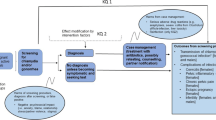Abstract
OBJECTIVES: We aimed to define priority areas for research on chlamydia, gonorrhea, and syphilis in Canada through the use of a consensus method.
METHODS: A modified Delphi method was conducted, consisting of two online surveys and an in-person meeting. Participants included people working in bacterial sexually transmitted infections (STIs) across Canada, including clinicians, policy-makers, public health practitioners, and researchers.
RESULTS: Consensus was achieved regarding the most important priority topics in bacterial STI research in Canada, within five general priority areas: the epidemiology of bacterial STIs, screening, partner notification and contact tracing, antimicrobial resistance, and identification of best practices for the prevention and control of bacterial STIs.
CONCLUSIONS: The findings of this consensus process can be used to inform research efforts, which could contribute to more effective control of bacterial STIs in Canada.
Résumé
OBJECTIFS: Nous avons tenté de définir des axes prioritaires d’intervention pour la recherche sur la chlamydiose, la gonorrhée et la syphilis au Canada par la méthode du consensus.
MÉTHODE: Nous avons employé une méthode Delphi modifiée, avec deux sondages en ligne et une réunion en personne. Les participants (cliniciens, responsables des politiques, praticiens de la santé publique, chercheurs) travaillaient au Canada dans le domaine des infections transmissibles sexuellement (ITS) d’origine bactérienne.
RÉSULTATS: Les participants se sont entendus sur les thèmes prioritaires les plus importants de la recherche sur les ITS bactériennes au Canada, à l’intérieur de cinq axes prioritaires d’intervention généraux: l’épidémiologie des ITS bactériennes; le dépistage; la notification des partenaires et le retraçage des contacts; la résistance antimicrobienne; et l’identification des pratiques exemplaires en matière de prévention et de lutte contre les ITS bactériennes.
CONCLUSIONS: Les constatations de ce processus consensuel peuvent servir à éclairer les efforts de recherche, lesquels pourraient contribuer à un contrôle plus efficace des ITS bactériennes au Canada.
Similar content being viewed by others
References
Low N, Broutet N, Adu-Sarkodie Y, Barton P, Hossain M, Hawkes S. Global control of sexually transmitted infections. Lancet 2006;368(9551):2001–16.
Wong T, Singh A, Mann J, Hansen L, McMahon S. Gender differences in bacterial STIs in Canada. BMC Women’s Health 2004;4 Suppl 1:S26.
Public Health Agency of Canada. Reported cases and rates of chlamydia by age group and sex, 1991 to 2009. Ottawa, ON: PHAC, 2010. Available at: http://www.phac-aspc.gc.ca/std-mts/sti-its_tab/chlamydia-eng.php (Accessed January 17, 2012).
Public Health Agency of Canada. Reported cases and rates of gonorrhea by age group and sex, 1980 to 2009. Ottawa: PHAC, 2010. Available at: http://www.phac-aspc.gc.ca/std-mts/sti-its_tab/gonorrhea-eng.php (Accessed January 17, 2012).
Public Health Agency of Canada. Reported cases and rates of infectious syphilis by age group and sex, 1993 to 2009. Ottawa: PHAC, 2010. Available at: http://www.phac-aspc.gc.ca/std-mts/sti-its_tab/syphilis-eng.php (Accessed January 17, 2012).
Hasson F, Kenney S, McKenna H. Research guidelines for the Delphi survey technique. J Adv Nurs 2000;32(4):1008–15.
Wathen CN, MacGregor JC, Hammerton J, Coben JH, Herrman H, Stewart DE, et al. Priorities for research in child maltreatment, intimate partner violence and resilience to violence exposures: Results of an international Delphi consensus development process. BMC Public Health 2012;12:684.
Weeks LC, Seely D, Balneaves LG, Boon HS, Leis A, Oneschuk D, et al. Canadian integrative oncology research priorities: Results of a consensus-building process. Current Oncol 2013;20(4):e289–99.
Sivananthan SN, Chambers LW. A method for identifying research priorities for health systems research on health and aging. Healthcare Management Forum 2013;26(1):33–36.
Haukoos JS, Mehta SD, Harvey L, Calderon Y, Rothman RE. Research priorities for human immunodeficiency virus and sexually transmitted infections surveillance, screening, and intervention in emergency departments: Consensus-based recommendations. Acad Emerg Med 2009;16(11):1096–102.
Aral SO, Over M, Manhart L, Holmes KK. Disease Control Priorities in Developing Countries, 2nd edition. Chapter 17. Sexually Transmitted Infections. Washington, DC: World Bank, 2006.
World Health Organization. Global Strategy for the Prevention and Control of Sexually Transmitted Infections: 2006–2015. Geneva, Switzerland: WHO Press, 2007.
World Health Organization. Sexually Transmitted Diseases Diagnostics Initiative. Available at: http://www.who.int/std_diagnostics/ (Accessed January 11, 2012).
Althaus CL, Heijne JC, Herzog SA, Roellin A, Low N. Individual and population level effects of partner notification for Chlamydia trachomatis. PLOS ONE 2012;7(12):e51438.
Hottes TS, Farrell J, Bondyra M, Haag D, Shoveller J, Gilbert M. Internet-based HIV and sexually transmitted infection testing in British Columbia, Canada: Opinions and expectations of prospective clients. J Med Internet Res 2012;14(2):e41.
National Collaborating Centre for Infectious Diseases. Partner Notification Project. Available at: http://www.nccid.ca/partner-notification (Accessed January 14, 2012).
Lusti-Narasimhan M, Ndowa F, Pires SS. Importance of sexually transmitted infections in funding for HIV within proposals to the Global Fund. Sex Transm Infect 2011;87 Suppl 2:ii19–22.
Fink A, Kosecoff J, Chassin M, Brook RH. Consensus methods: Characteristics and guidelines for use. Am J Public Health 1984;74(9):979–83.
Cole ZD, Donohoe HM, Stellefson ML. Internet-based Delphi research: Case based discussion. Environ Manage 2013;51(3):511–23.
Black N, Murphy M, Lamping D, McKee M, Sanderson C, Askham J, et al. Consensus development methods: A review of best practice in creating clinical guidelines. J Health Serv Res Pol 1999;4(4):236–48.
Cwikel JG, Lazer T, Press F, Lazer S. Sexually transmissible infections among female sex workers: An international review with an emphasis on hard-to-access populations. Sexual Health 2008;5(1):9–16.
Platt L, Jolley E, Rhodes T, Hope V, Latypov A, Reynolds L, et al. Factors mediating HIV risk among female sex workers in Europe: A systematic review and ecological analysis. BMJ Open 2013;3(7).
Author information
Authors and Affiliations
Corresponding author
Additional information
Acknowledgements: Funding for this project was provided by the Canadian Institutes of Health Research, grant 228262. Fiona Kouyoumdjian received salary support from a Fellowship from the Public Health Agency of Canada.
Conflict of Interest: None to declare.
Rights and permissions
About this article
Cite this article
Lee, C.QT., Kouyoumdjian, F. & Christian, J. Defining research priorities for bacterial sexually transmitted infections in Canada. Can J Public Health 105, e86–e90 (2014). https://doi.org/10.17269/cjph.105.4210
Received:
Accepted:
Published:
Issue Date:
DOI: https://doi.org/10.17269/cjph.105.4210




